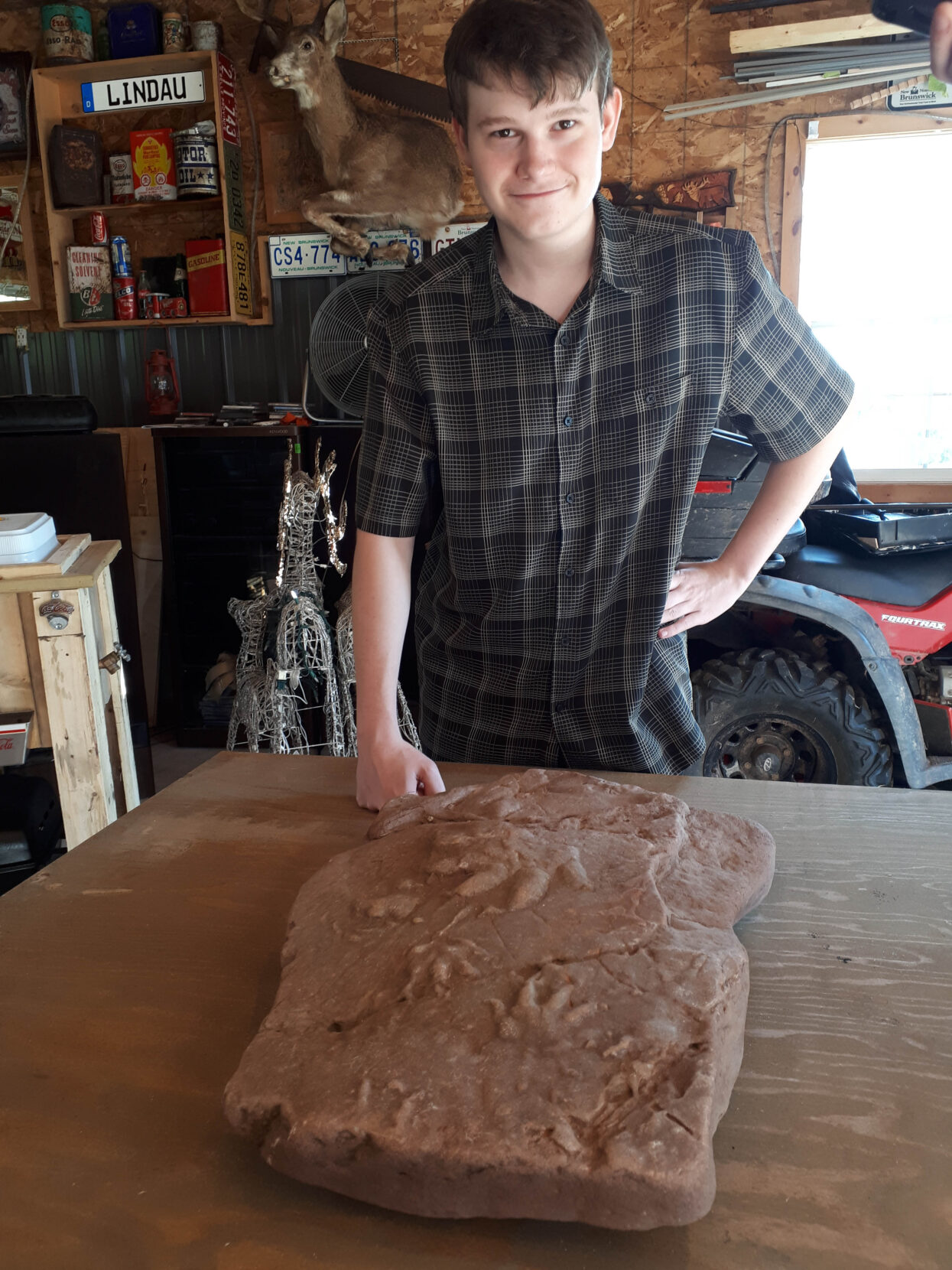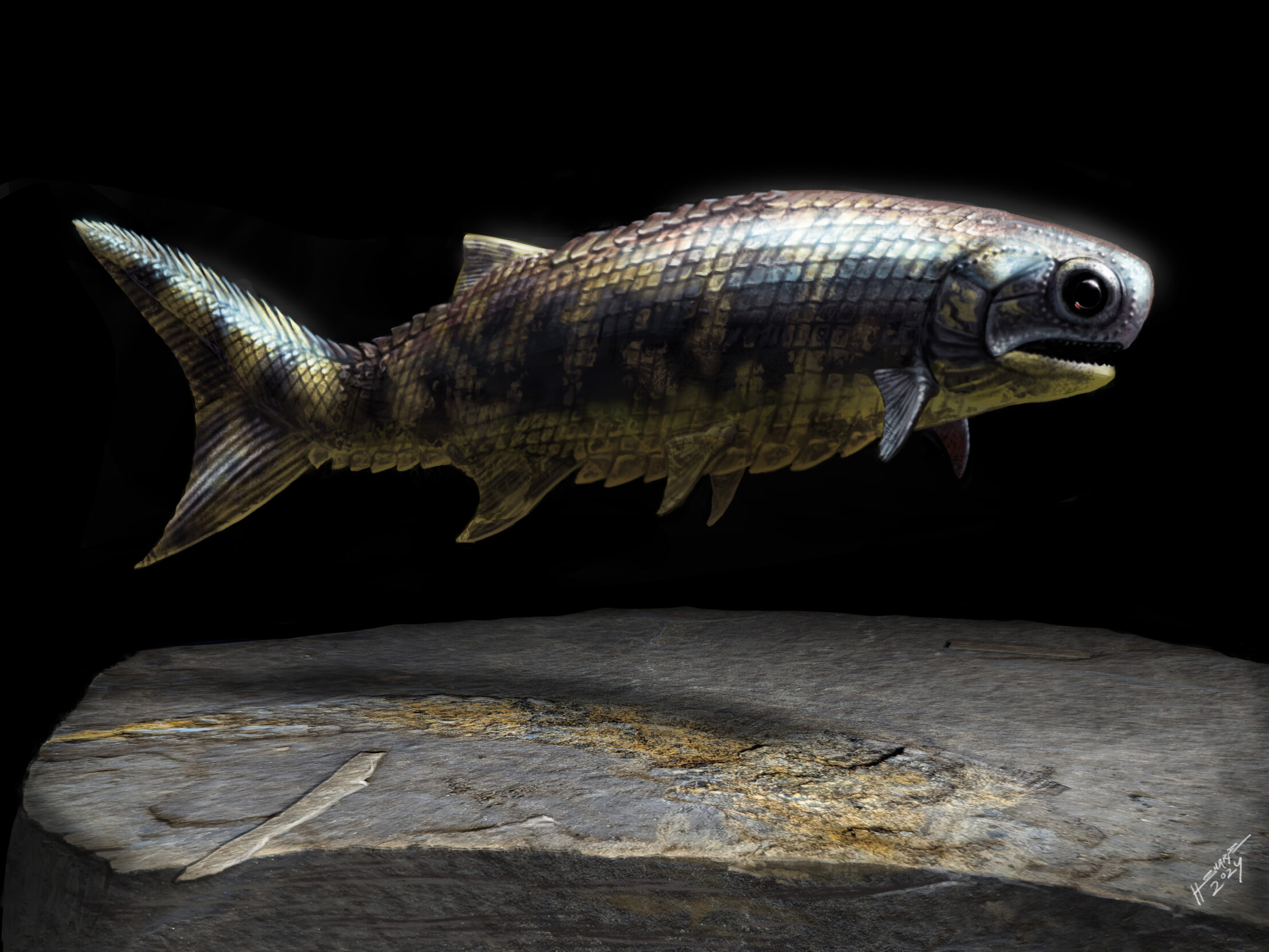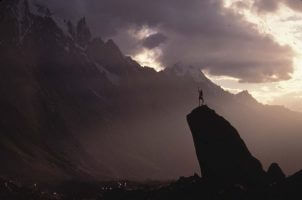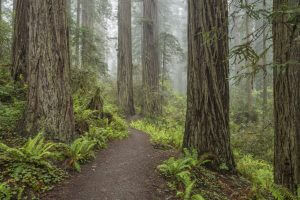Support Hidden Compass
Our articles are crafted by humans (not generative AI). Support Team Human with a contribution!
I pause on tiptoes at the edge of a 140-foot cliff, trying not to look down. A nylon spiderweb of a harness pulls against my pelvis, and my hands are so tight around the orange rappelling rope that I can almost feel its braided texture through a pair of too-large leather gloves. Behind me, low tide churns against the reef of Cape Enrage in New Brunswick, Canada, which extends like the scaly back of a sea monster surfacing from the depths and stretches almost halfway across Chignecto Bay toward Nova Scotia.
“Ready?” asks the belayer, college-aged and sandy-haired with skin basted Adonis gold in the sun.
I squeeze my eyes shut, letting the roar of the surf fill my ears and decelerate my heartbeat. “Good to go,” I say.
Beside me, the province’s head paleontologist, Matt Stimson, leans back against his own harness, helmet slightly askew. He grins and gives me an enthusiastic thumbs-up. We begin our descent hundreds of millions of years into the past.
Along the way, Stimson points out fossils frozen, Han Solo-like, in the rock face around Cape Enrage. Fragments of ferns with feathery tips that are almost indistinguishable from their modern-day counterparts. Cordaites, a prehistoric conifer-related seed plant with a long, stripy trunk and a bottle-brush top. Calamites, an extinct ancestor of the modern horsetail that grew up to 100 feet high and populated the understory of Carboniferous coal swamps. From plants to the tracks of prehistoric shrimp, crabs, and amphibians, these walls talk about biodiversity and the movement of animals inland as sea levels rose. The cliffs might even hold the secrets to animal evolution.
I dangle in the air for the last fifteen feet or so before my feet touch down on the sand and I unlatch my harness from the rope. I glance behind me at the waves that reveal the marvels once buried in this wall — and wonder what the water might carry away come high tide.
~~
On Dennis Beach, just seven miles from Cape Enrage, Stimson clambers atop a pile of rocks and ducks under a ruddy sandstone overhang, the stratified remains of an ancient river. Behind us, the Bay of Fundy crashes against the shore. Over the relentless squawks of seagulls, he shouts, “We’ve got tracks!”

An early amphibian leaves its footprints on the muddy ground of a Carboniferous swamp. Illustration: Henry Sharpe.
Stimson gestures for me to join him. As I squat close, our heads nearly touching, he points out stuttering zigzags across the rock — tiny amphibian footprints, no bigger than my pinky nail, and complete with impressions of dainty toes and pencil-lead-thin grooves made by a dragging tail or belly. During the Carboniferous Period, 359 to 299 million years ago, the animal walked across a layer of mud. The ground hardened in the sun and was buried under more mud. Fast-forward millions of years, and tectonic shifts flipped the rock layer — along with the amphibian’s footprints — upside-down, molding them into the cliff face.
I step back as Stimson, clad in cargo pants and a casual-Friday Oxford with rolled-up sleeves, draws a chisel and rock hammer from his pockets like a jolly gunslinger. He carefully taps out the footprint-embossed rock and places it on my outstretched palms for closer examination. The slice of sandstone is no more than a few ounces, but I feel its weight. This creature lived in a time when oxygen made up about 35 percent of the atmosphere, when lush tropical ecosystems, flying insects the size of seagulls, and 8-foot-long millipedes dominated the North American landscape. When humans were not even a glimmer in the great eye of evolution.
I hold the rock close to my face. Stimson, youthful face alight beneath a tan Tilley hat, says, “It’s going to have your name on it.”
~~
To be clear, the salamander-like critter will not be named after me, which is a blow to my inner fossil nerd. By virtue of my presence with Stimson, though, I’ll be recorded as a co-finder within the collection of the New Brunswick Museum, where Stimson serves as the acting curator of geology and paleontology.
My love of fossils was born in my youth and cultivated all the way through majoring in archaeology as an undergrad. Fearing I’d never make enough to live on, I left that career before it began, swapping it for the equally underpaid field of journalism. But geeky old habits die hard, and when Tourism New Brunswick invited me to explore the province, I immediately asked to be put in touch with an expert in the sciences. Stimson and I chatted over Zoom for nearly two hours, and I jumped at the offer to accompany him on a fossil ride-along.
In this moment, nothing could be of greater value than what I cradle, solidified in stone, in my hands.
Casual fossil discoveries are frequent in the mountains, quarries, and cliffs surrounding New Brunswick. The province, along with neighboring Nova Scotia, is known for one of the richest fossil records in the world.
Catrina Russell, geoscientist with Stonehammer UNESCO Global Geopark, explains, “From a paleontological perspective, we have rocks and fossils that tell an almost-continuous geologic story going back a billion years. The fossils represent basically every era of geologic time. You can see the entire evolution of life here.”
This remarkable outcome is thanks to the quirks of the Bay of Fundy, a 173-mile-long arm of the North Atlantic Ocean that flows through a 200-million-year-old rift valley between Nova Scotia and New Brunswick. Home to the world’s highest tides, the bay’s forceful waters continually turn up new finds like a natural paleontologist. Twice per day, under the gravitational pull of the moon, water channeling into the funnel-shaped basin rises up to 53 feet high and creates a sloshing “bathtub” effect. As author Harry Thurston puts it in Tidal Life: A Natural History of the Bay of Fundy, “Inch by inch, it drowns shaggy, seaweed-draped coastline, changing its shape like a compulsive cartographer constantly redrawing his charts.”
The redrawing means that hundreds of millions of years of history could be revealed in the course of a few hours. But come high tide, that history could just as easily be lost forever.
This puts researchers in a daily sprint to preserve the past.
~~
Seventy miles southwest of Dennis Beach along the southern coast of New Brunswick, a crimson-headed, blocky, white concrete lighthouse stands guard over fields of pink and yellow wildflowers and a narrow strip of rocky beach. The bracing waters of the Bay of Fundy lap over my feet as I walk, hoping to come across prehistoric treasure.
In 2020, the Graune-Greggs, a family from Sussex, New Brunswick, made the news while combing for sea glass here at Quaco Head.
“My son Lukeus sort of tripped over a rock,” recalls Gaby Graune-Gregg over a Zoom call. She sits shoulder to shoulder with her youngest child, a quiet twenty-something who was only eighteen at the time of the discovery. “He said, ‘Hey, Mom, look. I found something awesome.’ I was like, ‘Yeah, right.’”
The rock Lukeus stumbled over bore the unmistakable five-toed prints of Hyloidichnus, a catorhinomorph (lizard-like reptile), and the larger footprints of Pachypes, a bulldog-like reptile.
While experts had previously thought Quaco Head dated to the late Triassic, about 230 million years ago, the Graune-Greggs’ discovery is from the late Permian, about 260 million years ago, just before the mass extinction event that preceded the dinosaurs. An era of lowered sea levels, glaciation in the southern hemisphere, and desert conditions in North America, the Permian is when all the continents of the prehistoric world were interlinking to form the supercontinent Pangea — with New Brunswick in the center. This is also when the province’s spectacular “flower pot” rocks and sea caves were carved out of the coastline by the Bay of Fundy’s tides.
To collect important discoveries before nature washes them away, the province often relies on citizen scientists like the Graune-Greggs. Residents and visitors have been responsible for an astonishing number of unearthed treasures — upwards of 5,000 in the past five years alone.
Lukeus and Gaby emailed the New Brunswick Museum about their find, but didn’t hear back immediately. Lukeus encouraged his parents to bring it home. “There was a hurricane on the way. If we left it there, I knew it would be gone,” he remembers. “So we took it home, and took pictures of the place where we’d found it.”
Although removing a fossil from its site is not permitted in New Brunswick, Stimson was glad for the Graune-Greggs’ intervention in this case. The two-foot slab of rock, now on display at the Quaco Museum, is the youngest Permian fossil in Canada, and preserves the only late Permian footprints in North America.

Citizen scientists like Lukeus Graune-Gregg — posing here with his find — play a critical role in recovering the fossils of New Brunswick before they are swept out to sea. Photo: Matt Stimson.
~~
Historically considered one of the most hazardous navigational areas in the upper Bay of Fundy, Cape Enrage — where I dangled on rappelling ropes alongside a fervent Stimson — is a privately operated 6-acre park, raw and unembellished.
Over lunch in the park’s café, Stimson paints a verbal picture of the 60 million years before the Permian and Triassic.
“If you looked north or south from here during the Carboniferous, you would’ve seen ice-capped mountains. We would’ve been sitting in this tropical bowl, in a very humid wetland ecosystem.” He pauses, letting the giddy shouts of a preteen boy whizzing by on a nearby zipline fade. “This acted as a cradle of development for the early amphibians that stepped out of the water onto land.”
Paleontologists have known this for decades, but a breakthrough occurred when they stopped looking exclusively for bones. Stimson specializes in trace fossils like footprints, trackways, and coprolites (ossified feces) which, until relatively recently, were considered something akin to sorcery. But science, he says, isn’t just in the bones. In fact, trace fossils can often tell us more about the environment than the bones themselves.
Once dead, an animal’s skeleton can be scavenged and pulled apart by other animals or disarticulated by tides and flash floods. Where the bones are ultimately found isn’t necessarily where the animal lived. Trackways, on the other hand, are the smartwatches of history, documenting where steps happened in real time. “From trace fossils we can reconstruct entire ecosystems — all of the population dynamics, how the animals lived and moved. It’s bringing the animals and their environments back to life rather than simply telling us how they died,” Stimson explains.
Powered by two coffees, an iced tea, and a seemingly endless well of dad jokes, Stimson sketches maps and a timeline on the backs of Powerpoint printouts and hastily torn notebook paper. He taps his pen on the overlapping portion of a Venn diagram, explaining how shared derived characteristics, such as the morphology of the feet, change incrementally over the course of evolution and help scientists pinpoint time periods and animal families.
Footprints previously found on Dennis Beach, in the same area where I watched him excavate the tiny tracks, were dated to the Triassic Period. “This is roughly the time dinosaurs emerged,” Stimson says. “Dinosaurs are birds. Dinosaurs went extinct 66 million years ago when a large asteroid hit the earth and they had a bad day. So technically, this is the first time we’ve seen many birds killed with one stone.” He waits, a silent bah dum bum hanging in the air.
I roll my eyes and groan.
He chuckles, outlining a squiggly map of the areas we’ve visited. “All of these places are telling a chapter of the same story,” he says.
~~
In the morning, I steer the rental car, hazard lights blinking, down Highway 1 in Norton. We’re about an hour’s drive inland from Dennis Beach, between dense pine forests and lofty rock walls. I nurse a paper cup of tea as I pull the car onto the road’s shoulder and snap a flashing orange utility light to the edge of the roof, as far as its cigarette-lighter tether will allow. I step out into the sunlight, squinting as I don a reflective vest and hard hat.
Stimson waves toward a rock, which bears a cylindrical impression. I look closer and see a texture like snake scales.
“Lepidodendron!” he yells over the speeding pickups and sedans of New Brunswickers on their way to work. “Similar to modern lycopods, except they grew up to 180 feet tall. They were one of the most common trees in the swamps of the Carboniferous.”
In that era, when tropical wetlands populated by vascular plants dominated much of North America, plants grew tall because of the mildness of the year-round climate, which promoted continuous growth. The amniote egg, one of the greatest biological innovations of the period, allowed birds and reptiles to lay their eggs on land without concern of desiccation.
As Stimson moves from rock to rock, pointing out the remnants of tree roots and feathery leaves, a story begins to take shape: a fossil forest, preserved in situ.
“From trace fossils we can reconstruct entire ecosystems — all of the population dynamics, how the animals lived and moved. It’s bringing the animals and their environments back to life.”
At another stop, I fasten one hand to my hard hat to prevent passing traffic from blowing it off and hunker down by more imprints. Erosion from severe weather has caused the imprints to come close to the surface, where they continue to fade under the assault of sun, wind, and rain. Even before the natural degradation began, “rock hounds” were dismantling the site in the mid-2000s.
“It’s like a crime scene,” Stimson says. “The context of where the fossil comes from is so very, very important.”
This is especially true when the site is 350 million years old and one of just two forests of its kind on the planet.
~~
For paleontologists, Norton is emerging as one of the most important locations in New Brunswick. Besides the fossil forest, the site preserves rare evidence from Romer’s Gap, a roughly 15-million-year gap in the fossil record between the late Devonian and the early Carboniferous. Named for Harvard paleontologist Alfred Sherwood Romer, the lapse represents a crucial link between the primitive, water-dwelling, fishlike tetrapods of the Devonian and the creatures whose biological adaptations allowed them to live on land — our earliest terrestrial ancestors.
Norton retains some of the best-preserved fossil evidence of the early Carboniferous period. It’s one of only four localities on the planet that offers a window into Romer’s Gap — two are in the Borders area of Scotland, and one is in neighboring Nova Scotia. In New Brunswick, blasting through the rock to create Highway 1 accidentally revealed a trove of early life. What makes Norton different from the other early Carboniferous sites, all of which are coastal, is its inland location near freshwater. Scientists are still sussing out what this means.
“We’re finding new species of plants not identified elsewhere,” says Stimson, sketching a tree on a café napkin that looks like an upside-down toilet brush, and a fern with beefy fronds. I trace a fingertip over their outlines. They seem Seussian, unreal.
From a folder, he pulls a printout of more footprints. Amphibian, I think, then do a double take. Amphibians have four toes, but I count five. I frown up at Stimson. In 2019, he and colleague Olivia King excavated slabs of rock from Norton containing prints of several animals, including a salamander-sized amphibian with four toes on its front feet and five in the back. The find dates from between 330 to 360 million years ago, during Romer’s Gap.
Conclusions have yet to be drawn, but Stimson and King believe these unusual tracks, lined up in the same direction, might indicate that herd behavior developed millions of years earlier than previously thought.
~~
“You can see the entire evolution of life here.”
“This is an incredibly important site,” Stimson says with a game show host wave over the rutted ground of Albert Mines, about two hours from Saint John, the oldest and most famous city in New Brunswick. I quirk an eyebrow at what appears to be a pile of rubble surrounded by a greenish-brown, moat-like puddle.
Stimson scrambles partway up a rock pile and picks up a chunk of shale. Back home in the upper Hudson Valley of New York State, my house is built over layers of the stuff. It’s the world’s most common sedimentary rock and gardener’s nemesis. Stimson inserts a fingernail underneath a lip on the rock and carefully pries it open. When shales weather into a shiny, laminated form, depositing one atop the other in individual strata, they form paper shale. In between their “pages,” you can sometimes find treasures.
“Jackpot,” Stimson breathes, showing me a small, cocoon-shaped coprolite, or fossilized excrement.
I get to work, ignoring the beads of perspiration that make my glasses slip down my nose. When I find a promising mass among the debris, I pull apart layers of shale for evidence of . . . nothing.
As my discard pile grows, so does my irritation. I’m about to call it quits when I spy the hard edge of a layered hunk poking up from between rock shards. I brush away the smaller pieces and pull it out. First layer: nothing. Second layer: rock. Third layer: more rock. Fourth layer: I stop, heart racing. In my hands, I hold the top-down imprint of a fish, as if it were still swimming upright. The stone has preserved the outline of its skull and the fine bones of its tail spread into a miniature fan.
“I think I found something,” I say, forcing my voice to remain even.
I show my find to Stimson. “Look at that,” he says, “You just found a fish from Romer’s Gap. Well done!”
My exhilaration isn’t dampened by the clarification that I’m not the first to find this type of fish: that it’s a nice find, not a great one; or that the petrified poop Stimson found earlier could actually yield more interesting information. In this moment, nothing could be of greater value than what I cradle, solidified in stone, in my hands.

A fish from Romer’s Gap swims above its eventual fossil — to be unearthed, hundreds of millions of years later, by author Robin Catalano. Illustration: Henry Sharpe.
~~
It might have started as a rumble deep within the earth. The ground began to shudder, rattling the leaves of trees and altering the path and volume of subsurface waters. Flash flooding ensued. Trees and plant life were buried by landslides. Living creatures lucky enough to escape to higher ground were spared. Not so aquatic creatures, like scores of small, spindle-shaped, blunt-nosed fish that were snuffed out by the upwelling of anoxic lake waters. Lifeless, they sank, and were entombed beneath fine sediments in the deepest part of the lake.
Like Norton, Albert Mines is part of the Albert Formation, which dates to Romer’s Gap. Whereas Norton represents the area that was once close to the lakeshore, Albert Mines preserves the depths of the lake. Paleontologists have long known that Albert Mines is rich in fossils, but only recently began examining them more closely. Among the finds are the bones and scales of numerous Rhadinichthys alberti, a fish from the Mississippian period in the early Carboniferous. The mudslides that occurred near Norton — likely precipitated by an ancient earthquake — led to their unique mode of preservation which, according to Stimson, is found in few places worldwide. Albert Mines’ fossils are some of the best-preserved from the Mississippian period. At quarries farther south, near Saint John, researchers have also found numerous invertebrate tracks and burrows, as well as tiny amphibian footprints — some of the oldest evidence in North America of animals transitioning to land.
“We’re finding fossils at quite a pivotal point, and filling in part of an evolutionary gap that was previously unknown in the Maritimes,” says Rowan Norrad, a sophomore environmental science major at Acadia University with chiseled features under a mop of dark hair. He joins me on a video call from his parents’ home where he’s visiting for the holidays.
Norrad and friend Luke Allen are New Brunswick’s most prolific citizen scientists, having made more than 400 finds over the past decade. These include the imprint of a wing from a dragonfly that, in life, would have been about the size of a full-grown crow. The insect, he tells me, is now recognized as a new genus and species, and has been dubbed Brunellopteron norradi. I take a sip of water to prevent my expression from betraying the envy I feel over the Latinized eponym.
Both Norrad and Allen have been granted permits to fossil-hunt, which means submitting reports of their findings and turning specimens over to the museum. Beyond the wonder of finding evidence of a fantastical creature, looking for fossils in New Brunswick confers an elite status.
Norrad explains, “When I flip over a rock on the beach and I see a fossil, I’m the first person ever to see that organism. There were no people around when it lived. No one’s ever touched it. In that moment, I’m the only one. It just blows my mind. That’s what keeps me coming back.”
~~
I spend my final evening in Saint John, where a bell buoy gongs solemnly and the acrid scents of the harbor hang on the wind. I lean over the boardwalk railing, rain jacket zipped against the drizzle, and spread open my hands, still feeling the weight and flinty texture of the fish fossil from Albert Mines.
This creature lived in a time … when humans were not even a glimmer in the great eye of evolution.
I think of the beaches and quarries I’ve visited here in New Brunswick, how my visit could have been completely different if I’d arrived only one day before. Although the tide has yielded numerous historical riches in the space of my weeklong visit, it has also, invariably, taken away. The pattern will repeat itself as long as the Bay of Fundy rises and falls.
All we can do is come back tomorrow, and the next day, and the next, to see what other fossils the sea might be willing to share — until they vanish again under another sweep of water.
# # #
Henry Sharpe is a Canadian natural sciences illustrator who specializes in prehistoric life. He is a paleontology student at the University of Alberta with a penchant for hiking in Crocs.
Robin Catalano
A specialist in coastal travel, the Northeastern U.S., animal conservation, food and craft beverages, and Spain, Robin Catalano is a travel journalist and the creator of the travel blog Once More to the Shore.



